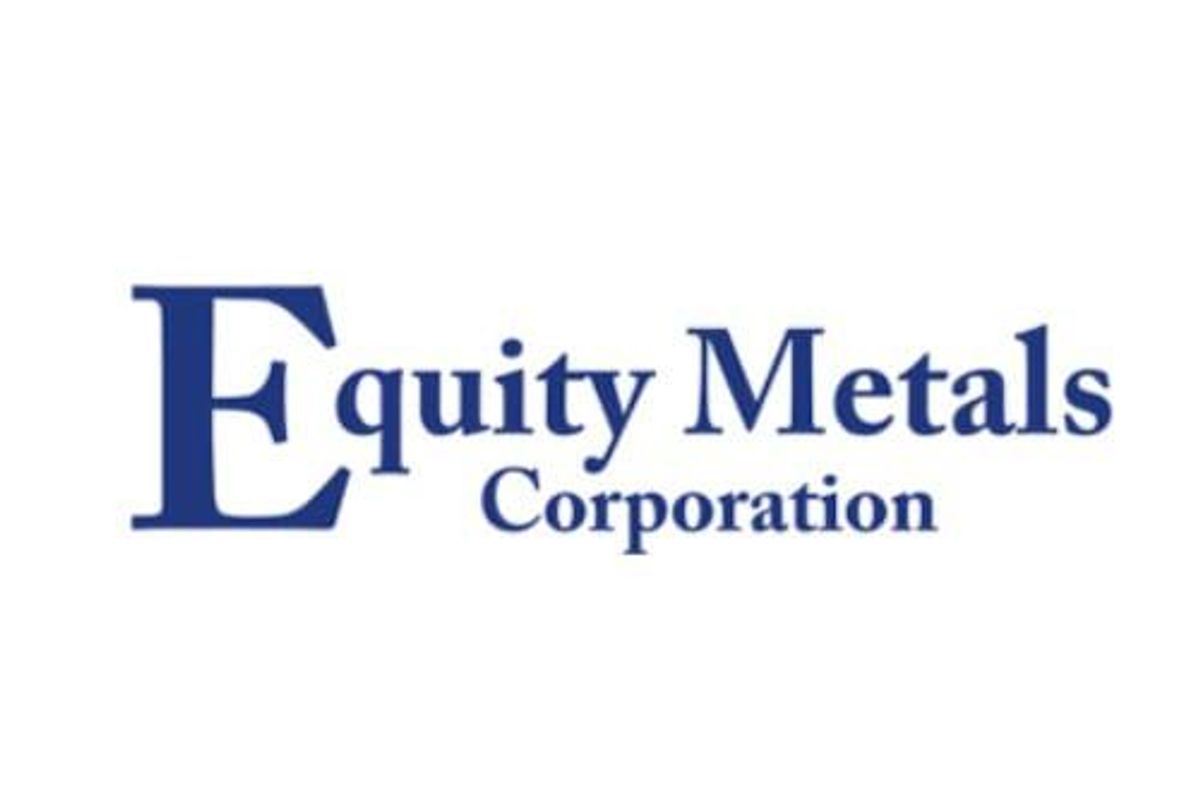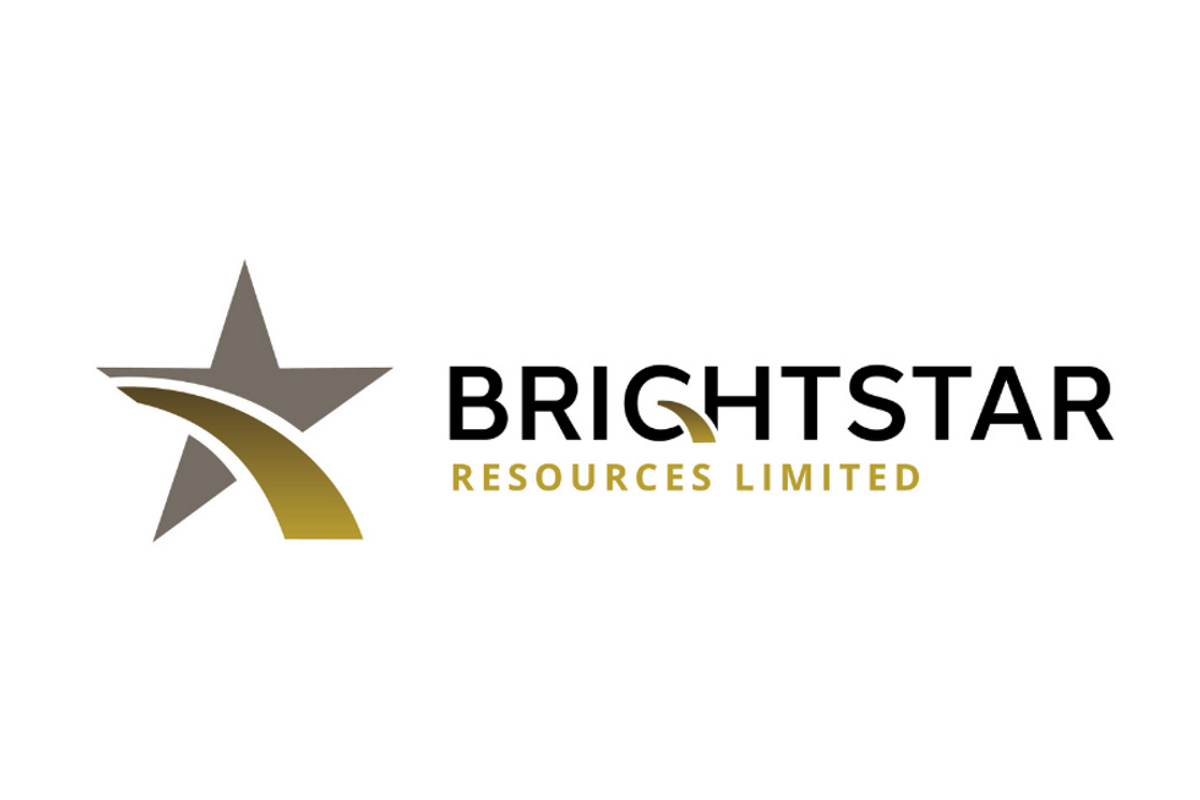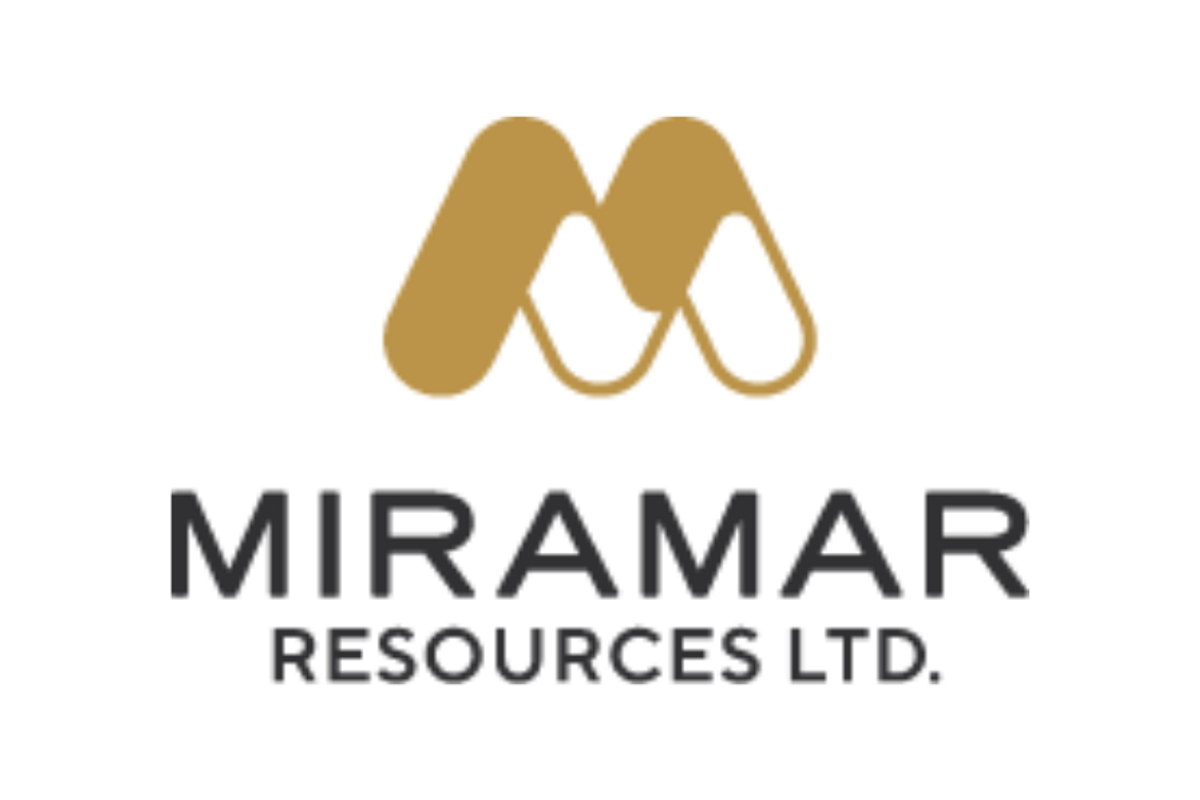
- NORTH AMERICA EDITIONAustraliaNorth AmericaWorld
Investing News NetworkYour trusted source for investing success
July 23, 2023
Miramar Resources Limited (ASX:M2R, “Miramar” or “the Company”) is pleased to advise that it has received Programme of Work (POW) approval for drilling at the 100%-owned Mount Vernon Ni-Cu-PGE Project in the Gascoyne region of Western Australia.
The Mount Vernon Project is one of several granted or pending Exploration Licences which make up the Company’s 100% owned Bangemall Project.
The Company has received POW approval for RC and/or diamond drilling at Mount Vernon which will test Ni-Cu-PGE targets associated with Kulkatharra Dolerite sills and highlighted by historic geochemical sampling and Miramar’s 2022 airborne EM survey (Figure 1).
Miramar’s Executive Chairman, Mr Allan Kelly, said the Mount Vernon Project had several high-priority drill targets which could result in the discovery of a new style of nickel mineralisation in WA.
“Geoscience Australia and the GSWA both identified the potential for the Kulkatharra Dolerite sills to host significant Ni-Cu-PGE mineralisation such as the giant Norilsk deposits in Siberia,” Mr Kelly said.
“Despite this, very little relevant project-scale work has been completed to date,” he added.
“At Mount Vernon, our detailed magnetic and EM survey highlighted a number of highly conductive late- time EM anomalies inboard of the outcropping basal contact of a dolerite sill which has several significant historic nickel and copper results in soil and rock chip samples,” Mr Kelly said.
“The modelled plate over the highest priority target has a similar footprint to the ground EM anomaly outlined at Nova-Bollinger prior to the discovery drill hole,” he added.
Upcoming Work Programme
The Company is planning the following at Mount Vernon following completion of drilling at Whaleshark:
- Rock chip and/or soil sampling along the basal contact
- Orientation ground EM surveys over selected airborne EM anomalies
- Finalising drill hole locations based on the above results
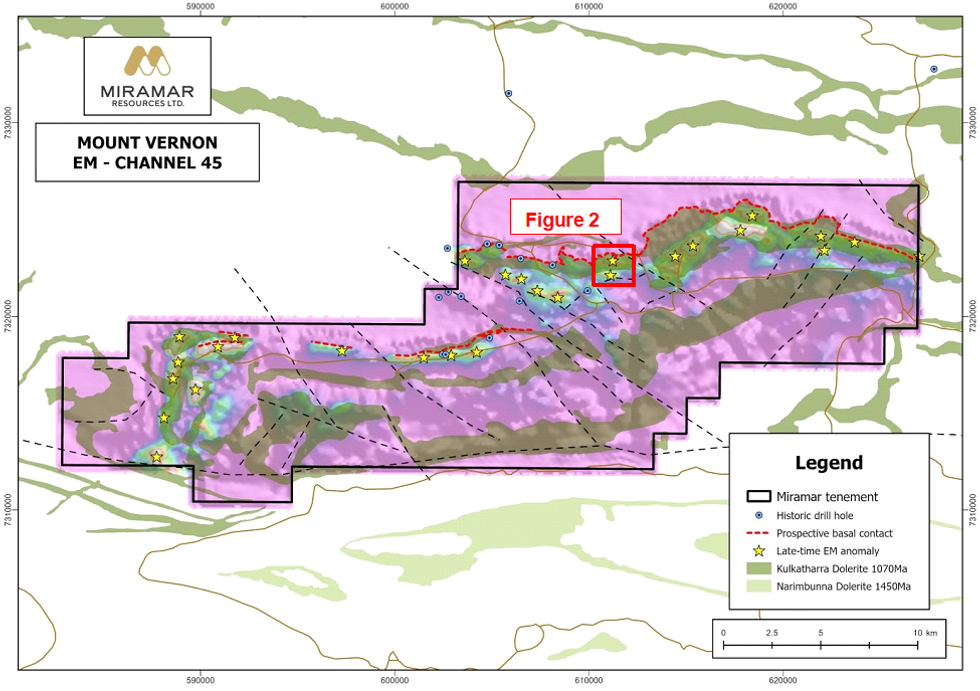
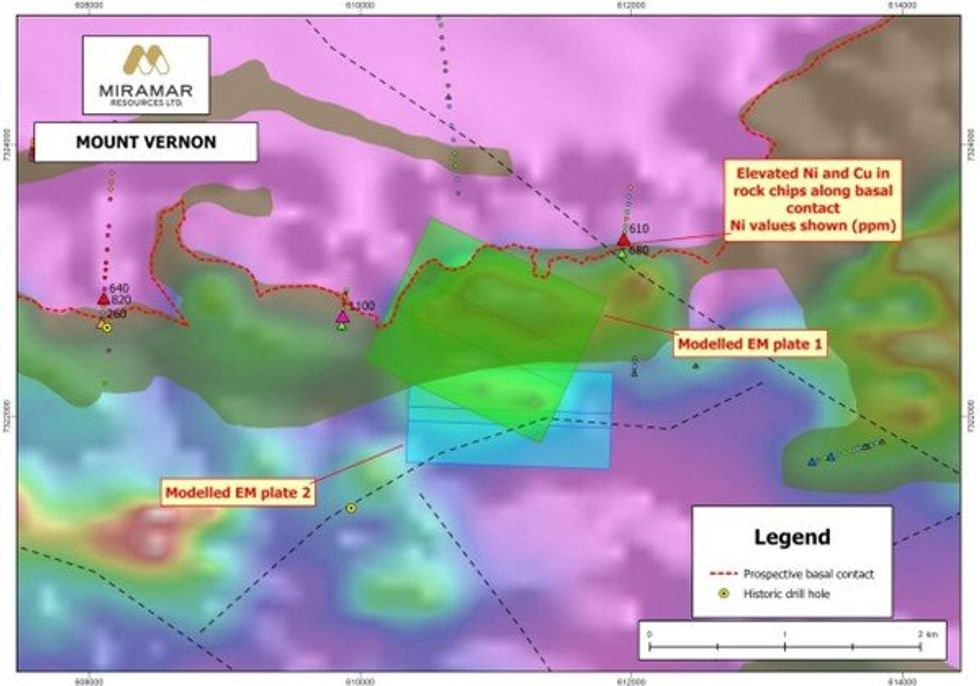
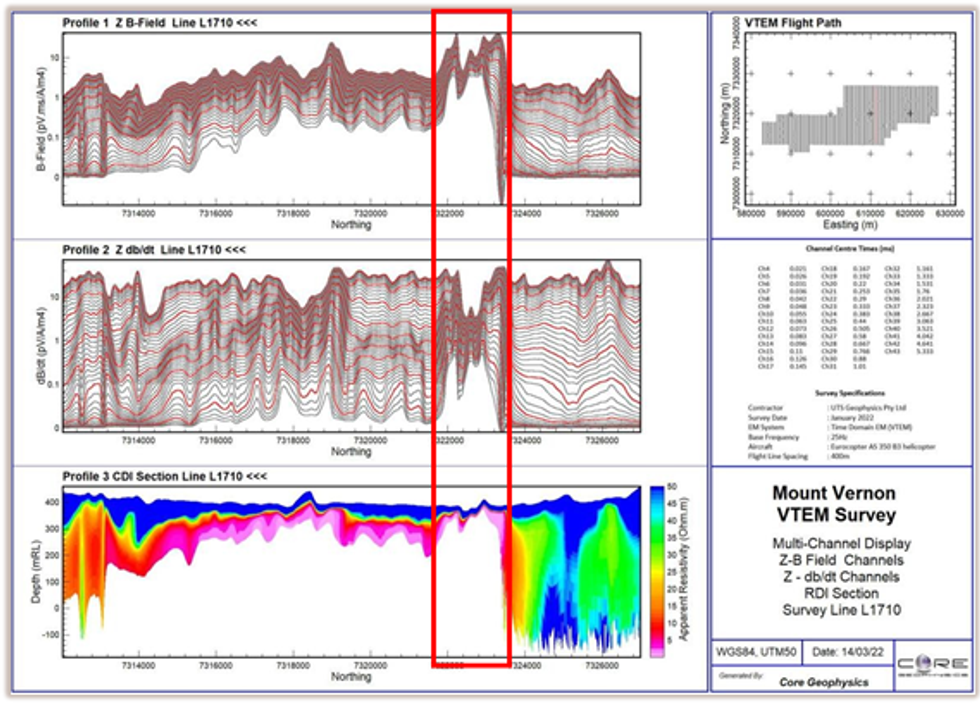
COMPETENT PERSON STATEMENT
The information in this report that relates to Exploration Targets or Exploration Results is based on information compiled by Allan Kelly, a “Competent Person” who is a Member of The Australian Institute of Geoscientists. Mr Kelly is the Executive Chairman of Miramar Resources Ltd. He is a full-time employee of Miramar Resources Ltd and holds shares and options in the company.
Mr Kelly has sufficient experience that is relevant to the style of mineralisation and type of deposits under consideration and to the activity being undertaken to Qualify as a “Competent Person” as defined in the 2012 Edition of the ‘Australasian Code for Reporting of Exploration Results, Mineral Resources and Ore Reserves’.
Click here for the full ASX Release
This article includes content from Miramar Resources Limited, licensed for the purpose of publishing on Investing News Australia. This article does not constitute financial product advice. It is your responsibility to perform proper due diligence before acting upon any information provided here. Please refer to our full disclaimer here.
The Conversation (0)
8h
Completed Sale of Lochinvar Coal Project and Royalty Deed
New Age Exploration (NAE:AU) has announced Completed Sale of Lochinvar Coal Project and Royalty Deed
9h
Munda Gold Mine - Purchase of Mine Camp, Nickel Rights and Water Assets from WIN Metals
Auric Mining Limited (ASX: AWJ) (Auric or the Company) together with WIN Metals Ltd (ASX: WIN) (WIN Metals or WIN) are pleased to announce that the two parties have successfully agreed to the purchase of a package of WIN assets including all nickel and associated minerals rights, water access rights and a fully equipped mining camp all relating to Auric’s Munda Gold Mine.
Highlights
- This milestone agreement considerably enhances Auric’s mining operations at its Munda Gold Mine.
- Acquisition includes a fully equipped mining camp and all related assets six kilometres from Munda Gold Mine.
- All Nickel rights and entitlements will be owned by Auric.
- Sole access and usage of stored water in the 132N pit by Auric.
- Total purchase price $1.4 Million (ex GST), payable in two tranches: Tranche 1 $900,000 paid 30 June 2025, Tranche 2 $500,000 due 31 July 2025.
Management Comment
Managing Director, Mark English, said:“This acquisition gives Auric greater control over our destiny for open pit mining at our Munda Gold Mine.
“Buying all nickel rights from WIN sees us taking another major step forward at Munda. We’ve moved mining at Munda along rapidly this year and are pleased this hurdle to progress our future expansion will be removed.
“There’s not much water around Widgiemooltha, so as part of this transaction, we are acquiring additional access to stored water in the 132N pit. Having adequate water is extremely important for our mining operations. The mining camp is another huge bonus for Auric being located just six kilometres north of our mine.
“We have reached a highly satisfactory agreement for all Auric shareholders,” said Mr English.
WIN Metals. Managing Director and CEO, Steve Norregaard, said:“WIN wish Auric all the best with their Munda gold project development.
“Proposed Nickel mining at Munda was not contemplated in WIN’s 2024 scoping study and as such would have been far into the future for the Mt Edwards Nickel Project. With the outlook of a prolonged subdued nickel price the opportunity to monetise a relatively small portion of the total projects nickel resource base will provide cash for investment into WIN’s gold assets. This is a transaction that makes sense for both companies,” said Mr Norregaard.
The Announcement
The total consideration is $1.4 million, (ex GST) payable in two separate tranches: the first tranche of $900,000 paid on 30 June 2025, the second, $500,000 due on or before July 31, 2025.
Included in the purchase is a fully equipped mining camp located six kilometres north of the Munda Gold Mine sufficient to house the entire workforce. Additional in the deal, Auric has also acquired sole access to all the water in the pit at 132N, just a short distance from the Munda mine.
Auric will at completion own all mineral rights at Munda, except lithium. The lithium mineral rights remain with WIN.
Upon completion of both tranches, on or before 31 July 2025, Auric will have paid WIN a total of $1.4 million (ex GST), for the mining camp, which includes all associated infrastructure such as solar panels, generators, bulk fuel storage, storage containers together with water rights to the 132N pit and all nickel rights and associated entitlements at Munda. The parties have agreed to expedite the grant of miscellaneous licences over the WIN tenements to secure road access as well as the camp.
Click here for the full ASX Release
This article includes content from Auric Mining, licensed for the purpose of publishing on Investing News Australia. This article does not constitute financial product advice. It is your responsibility to perform proper due diligence before acting upon any information provided here. Please refer to our full disclaimer here.
Keep reading...Show less
17h
Equity Metals
Investor Insight
Equity Metals offers investors exposure to high-grade silver and gold discoveries in British Columbia through a dual-track strategy of expanding its flagship Silver Queen resource and advancing the newly acquired Arlington district.
Overview
Equity Metals (TSXV:EQTY,OTCQB:EQMEF,FSE:EGSD) is fast-tracking exploration at its 100 percent owned Silver Queen project in British Columbia, targeting resource expansion and derisking of one of the province's most prospective high-grade polymetallic deposits. Located within the prolific Skeena Arch near the historic Equity Silver and Huckleberry mines, Silver Queen boasts an NI 43-101 compliant resource of 62.8 million ounces (Moz) silver equivalent (indicated) and 22.5 Moz silver equivalent (inferred), with 2024 drilling extending known zones and identifying new mineralized areas.
Complementing this is the Arlington gold-copper-silver project, a newly acquired district-scale, never-before drill-tested project located in southern BC's Greenwood Mining Division. With analogues to historic producers like Phoenix and Buckhorn, Arlington is being aggressively explored with 3,000 meters of drilling underway, focused on delineating high-grade gold-enriched polymetallic mineralization.
Parameters for the NI 43-101 Compliant Mineral Resource Estimate are in the Appendix and in the EQTY News Release, dated Dec 1, 2022
Together, Silver Queen and Arlington offer a balanced exposure to high-grade polymetallic and gold-rich systems. The former provides near-term resource expansion and development optionality, while the latter opens up district-scale discovery potential.
In addition, Equity Metals holds interests in the Monument and WO diamond properties in the Lac de Gras region (Northwest Territories), proximal to the Diavik and Ekati mines, and the La Ronge silica project in Saskatchewan. These projects offer upside optionality for strategic partnerships or asset sales.
Company Highlights
- Flagship High-grade Project – Silver Queen: Over 85 million silver-equivalent ounces defined in the heart of BC's Skeena Arch mineral belt, surrounded by Tier 1 infrastructure and historical producers.
- New Gold Discovery Potential – Arlington project: A district-scale, early-stage gold-copper-silver system with analogues to major past-producing skarn and vein-hosted mines in the region.
- Fully Funded for 2025: 9,000 meters of combined drilling is underway across both Silver Queen and Arlington with assay results expected to drive news flow through Q3 and Q4 2025.
- Experienced Management and Technical Team: Track record of discovery and mine development across North America, including the Penasquito and Eskay Creek mines and the Wind Mountain project.
- Exposure to Critical and Precious Metals: Balanced portfolio spanning silver, gold, copper and diamonds with optionality in battery materials (silica) and critical minerals.
Key Projects
Silver Queen Project

The Silver Queen project is Equity Metals’ 100 percent owned flagship asset located in central British Columbia’s prolific Skeena Arch, approximately 35 km south of Houston. This 18,871-hectare property consists of 17 crown-granted titles and 46 tenure claims in the Omineca Mining Division. Surrounded by past-producing and active mines, including the Equity silver mine, Berg, Endako and Mt. Milligan, the project benefits from established infrastructure such as roads, power and rail access.
Silver Queen hosts a high-grade polymetallic system featuring silver, gold, copper, lead and zinc mineralization. The project is underpinned by a robust NI 43-101 compliant resource estimate (as of December 2022) consisting of 62.8 million ounces (Moz) silver-equivalent (AgEq) in the indicated category grading 565 grams per ton (g/t) AgEq, and 22.5 Moz AgEq in the inferred category grading 365 g/t AgEq. This includes 3.46 million tons (Mt) of indicated resources averaging 189 g/t silver, 2.13 g/t gold, 0.24 percent copper, 0.6 percent lead, and 3.5 percent zinc, and 1.92 Mt of inferred resources grading 167 g/t silver, 0.82 g/t gold, 0.23 percent copper, 0.5 percent lead, and 2 percent zinc.
The mineralization occurs in multiple steeply dipping epithermal vein systems, subdivided into the No. 3, NG-3, Camp and Sveinson veins. Each exhibits distinct metal zonation – the Camp veins are silver-dominant, while the Sveinson, No. 3 and NG-3 show a stronger gold bias. Bonanza grades have been intercepted at multiple locations, including down-hole drill core intervals assaying up to 56,115 g/t silver over 0.3 metres in recent drill results. High sulphide and low sulphide vein environments have both been identified, suggesting a long-lived and multi-phase mineralizing event.

Since late 2020, Equity has completed 52,877 meters of drilling in 146 holes, targeting extensions and new zones of mineralization. In 2024 alone, four target areas – George Lake, Camp North, No. 3 North and Camp-Sveinson – were tested via 17,209 meters across 42 holes. Drilling resulted in the delineation of a 550-metre strike-length for mineralization in the George Lake target and a 400-metre strike-length for mineralization in the No. 3 North target, as well as several extensions of earlier identified veins in the Camp Deposit and a new discovery in the Camp North target. A 6,000-meter 2025 drilling program will further test these zones with updated modeling and resource growth expected in Q3 2025.
Metallurgical testing completed in both 1988 and 2022 yielded positive recoveries: 83 percent gold, 95 percent silver, 93 percent copper, 91 percent lead, and 98 percent zinc. A follow-up metallurgical program is planned to support preliminary development studies. With extensive underground development (~9 km of historic workings) and proximity to key infrastructure, the Silver Queen project is well positioned for advancement toward economic studies and ultimately, a potential strategic transaction.
Arlington Project

The Arlington project is a 3,584-hectare, early-stage exploration asset located in southern British Columbia’s Greenwood Mining Division, approximately 65 km south of Kelowna. The project sits within the prolific Quesnel Terrane and is accessible year-round via Highway 33 and a network of logging roads. The region hosts several historical producers including the Buckhorn, Phoenix, and Beaverdell mines, which have collectively yielded more than 2 Moz gold, 6 Moz silver and 500 Mlb copper.
Arlington encompasses multiple mineral occurrences and at least four deposit styles across a more than 5 km strike length. Historic and recent surface work has confirmed high-grade mineralization with rock samples returning values up to 11.67 g/t gold, 211 g/t silver, and 3.22 percent copper. The 2025 exploration program, currently underway, includes a 3,000-metre drill campaign primarily targeting the Fresh Pots gold-silver anomaly – a large (2 km x 1 km) intrusion-related gold system delineated by multi-element soil geochemistry and magnetic lows.
Other high-priority targets include:
- Rona Porphyry Target: A copper-molybdenum-gold system with pyroxenite intrusive-hosted mineralization. Rock chip assays have returned >1 percent molybdenum, 0.6 g/t gold, and 32.4 g/t silver. The area is characterized by a large copper-nickel soil anomaly and widespread argillic alteration in adjacent sedimentary rocks.
- Arlington Polymetallic Veins: A structurally controlled vein system with documented historic workings. Highlights include Arlington South (11.67 g/t gold, 3.22 percent copper) and Arlington North (1.86 g/t gold, 1.07 percent copper), suggesting vertical metal zonation and potential for stacked vein systems.
- Skarn and Replacement Targets: Notably at the Bru and Arlington zones, analogous to Buckhorn and Phoenix, where gold-copper magnetite skarns produced over 1 Moz historically.
In early 2025, Equity Metals completed a property-wide airborne magnetic/radiometric survey and LiDAR mapping campaign to refine targeting. Soil and till geochemistry, IP surveying and mapping continue across the license area to delineate follow-up drill targets for 2026.
Management Team
Lawrence Page – Chairman and Director
A seasoned mining executive with over four decades of experience, Lawrence Page has helped finance and develop several major discoveries including Penasquito (Mexico), Eskay Creek and Hemlo. He brings strategic oversight and a deep network within the exploration and capital markets community.
Joseph A. Kizis Jr. – President and Director
With over 40 years of mineral exploration experience, Joseph Kizis has been instrumental in advancing gold, silver and base metal projects across North America. He is also president of Bravada Gold and has played key roles in advancing Wind Mountain in Nevada and Homestake Ridge in BC.
Robert W.J. Macdonald – VP Exploration
Robert Macdonald leads Equity Metals’ technical team and brings extensive epithermal and porphyry system expertise. His past project experience includes Homestake Ridge in BC and Cerro Las Minitas in Mexico, and he is the Qualified Person for all technical disclosures.
Killian Ruby – CFO and Director
As president and CEO of Malaspina Consultants and a former senior manager at KPMG LLP, Killian Ruby brings financial discipline, governance strength and tax expertise. He also serves as CFO for several junior resource companies.
John Kerr – Director
A professional engineer with five decades of exploration experience, John Kerr has contributed to the discovery and development of projects such as Santa Fe and Mindora in Nevada, and Frasergold in BC.
Courtney Shearer – Director
Courtney Shearer has served in executive and advisory roles with multiple Canadian mining companies, including San Gold Corporation, where he led strategic evaluations and project planning initiatives.
Arie Page – Corporate Secretary
Arie Page provides legal and corporate compliance support and has served as corporate secretary for numerous public companies within the Manex Resource Group.
Appendix:
Silver Queen Mineral Resource Estimate (NI 43-101 Compliant, Dec. 1, 2022) (C$100 NSR cut-off)
- The current Mineral Resource Estimate was prepared by Garth Kirkham, P.Geo., of Kirkham Geosystems Ltd and Eugene Puritch, P. Eng., FEC, CET and Fred Brown, P, Geo. of P&E Mining Consultants Inc. (“P&E”), Independent Qualified Persons (“QP”), as defined by National instrument 43-101.
- All Mineral Resources have been estimated in accordance with Canadian Institute of Mining and Metallurgy and Petroleum (“CIM”) definitions, as required under National Instrument 43-101 (“NI43-101”).
- Mineral Resources were constrained using continuous mining units demonstrating reasonable prospects of eventual economic extraction.
- Silver and Gold Equivalents were calculated from the interpolated block values using relative process recoveries and prices between the component metals and silver to determine a final AgEq and AuEq values.
- Silver and Gold Equivalents and NSR$/t values were calculated using average long-term prices of $20/oz silver, $1,700/oz gold, $3.50/lb copper, $0.95/lb lead and $1.45/lb zinc. All metal prices are stated in $USD. The C$100/tonne NSR cut-off grade value for the underground Mineral Resource was derived from mining costs of C$70/t, with process costs of C$20/t and G&A of C$10/t. Process recoveries used were Au 70%, Ag 80%, Cu 80%, Pb 81% and Zn 90%.
- Grade capping was performed on 1m composites for the No. 3 and NG-3 veins and whole vein composites for the Camp and Sveinson veins. For the No. 3 and NG-3 veins Inverse distance cubed (I/d3) was utilized for grade interpolation for Au and Ag and inverse distance squared (I/d2) was utilized for Cu, Pb and Zn. Inverse distance squared (I/d2) was used for all metals in the Camp and Sveinson veins.
- A bulk density of 3.56t/m3 was used for all tonnage calculations in the No. 3 and NG-3 veins. A variable density with a 3.15 average was used for the Camp and Sveinson veins.
- Mineral Resources are not Mineral Reserves until they have demonstrated economic viability. Mineral Resource Estimates do not account for a Mineral Resource’s mineability, selectivity, mining loss, or dilution.
- An Inferred Mineral Resource has a lower level of confidence than that applying to an Indicated Mineral Resource and must not be converted to a Mineral Reserve. It is reasonably expected that the majority of Inferred Mineral Resources could be upgraded to Indicated Mineral Resources with continued exploration.
- All figures are rounded to reflect the relative accuracy of the estimate and therefore numbers may not appear to add precisely.
Keep reading...Show less
19h
Zijin Mining to Acquire Major Kazakh Gold Mine for US$1.2 Billion
China’s Zijin Mining Group (OTC Pink:ZIJMF,HKEX:2899,SHA:601899), the country’s largest producer of gold and copper, has agreed to acquire Kazakhstan’s Raygorodok gold mine for US$1.2 billion.
The deal, announced on Monday (June 30) through a filing to the Hong Kong Stock Exchange, furthers the company’s ambition of becoming one of the world’s top three gold producers by 2028.
Raygorodok is reportedly among the largest and most technologically advanced gold projects in Central Asia. It produced 6 metric tons of gold in 2024 at a production cost of US$796 per ounce, excluding non-cash items.
With a remaining mine life of 16 years and average annual output of 5.5 metric tons of gold, Zijin expects the mine, located in Northern Kazakhstan, to boost both its earnings and production starting this year.
Raygorodok's total ore reserves are estimated at 94.9 million metric tons, containing approximately 100.6 metric tons (3.5 million ounces) of gold, based on a gold price of US$1,750 per ounce.
However, Zijin believes that considering the current market for the yellow metal, there is clear potential to expand production and reserves by improving the pit design under a higher gold price assumption. Furthermore, a US$420 million processing plant, operational since mid-2022, has significantly expanded the mine’s output capacity.
Annual production rose from 50,000 ounces in 2023 to an expected 190,000 ounces in 2025, using carbon-in-pulp and heap-leaching technologies that improve extraction efficiency from low-grade ore. As of the end of 2024, Raygorodok reported net assets of US$291 million and posted a net profit of US$202 million on US$473 million in revenue.
The asset is currently owned by Cantech, a Kazakhstan-based firm 65 percent held by V Group International, one of the country’s largest equity investment companies, and backed by US private equity firm Resource Capital Funds.
Through its subsidiaries, Zijin Gold International and Jinha Mining, Zijin signed definitive agreements to purchase all rights and interests in RG Gold and RG Processing, the Kazakhstan-based entities that own and operate the mine.
The acquisition is expected to close by the end of September of this year, pending regulatory approvals from both Chinese and Kazakh authorities.
Zijin Gold IPO in the works
Zijin operates gold mines in China and globally in locations such as Africa and South America.
But Raygorodok is set to become one of its flagship assets, aligning with the group’s goal of raising annual gold production by 35 percent — from 73 metric tons in 2024 to 100 to 110 metric tons by 2028.
The acquisition also serves a broader corporate strategy: the planned initial public offering (IPO) of Zijin Gold International, the group’s overseas gold division, on the Hong Kong Stock Exchange.
Established in 2007, Zijin Gold International is being positioned as the vehicle for consolidating Zijin’s foreign gold assets and unlocking shareholder value. The IPO is expected to raise between US$1.5 billion and US$2 billion. Proceeds will be used for further expansion across Africa and South America.
The spinoff remains subject to approval from Chinese regulators, Zijin shareholders, the Hong Kong Securities and Futures Commission and the Hong Kong Stock Exchange.
Zijin has emphasized that the listing will not affect its control over the subsidiary. Furthermore, Zijin Gold International will remain under Zijin's consolidated financial statements post-listing.
Don’t forget to follow us @INN_Resource for real-time updates!
Securities Disclosure: I, Giann Liguid, hold no direct investment interest in any company mentioned in this article.
Keep reading...Show less
19h
Mali Completes Takeover of Abandoned Gold Mines, Extends Push for Resource Sovereignty
Mali’s military-led government has completed its takeover of the Yatela and Morila gold mines.
Reuters reported on Monday (June 30) that according to the Malian government, control of the Yatela mine in Western Kayes and the Morila mine in Southern Sikasso has officially been transferred to the Society for Research and Exploitation of Mineral Resources of Mali (SEMOS), a newly formed entity in the country.
The Yatela mine was abandoned in 2016 by Sadiola Exploration Company — a joint venture between South Africa’s AngloGold Ashanti (NYSE:AU,JSE:ANG) and Canada’s IAMGOLD (TSX:IMG,NYSE:IAG) — after the operators deemed continued production uneconomic despite leftover reserves.
Morila, once one of Mali’s flagship gold sites, was abandoned in 2022 by Australia’s Firefinch, which had taken over the site from Barrick Mining (TSX:ABX,NYSE:B) and AngloGold. Mali’s government says Morila was left with “significant environmental and financial liabilities,” raising concerns about whether SEMOS can turn operations around profitably.
These moves are part of a broader push by Mali’s military government, which came to power after coups in 2020 and 2021, to restructure the gold sector and capture more revenue from high commodities prices.
Mali produces around 65 metric tons of gold annually, making it Africa’s second largest producer, yet it lacks an internationally certified refinery and is heavily dependent on foreign operators for both technology and market access.
Earlier this year, Business Insider Africa reported that the country had started construction on a Russia-backed gold refinery, another step meant to increase control over its natural resources.
Since taking power, Mali’s authorities have steadily pressured miners via higher taxes, tougher licensing conditions and new contract terms aligned with its 2023 mining code, which grants the state a bigger stake in operations.
Yet critics caution that simply taking over mines without clear management plans or technical expertise risks undercutting investor confidence and missing out on today's high gold price.
Gold is up 28.5 percent year-to-date, hitting an all-time high of US$3,500 per ounce in April, driven by geopolitical fears and US President Donald Trump’s aggressive tariff policy.
Mali's ongoing dispute with Barrick Mining
Mali’s relationship with Barrick has soured amid the country's move to exert resource sector control.
Earlier this month, a commercial court in Bamako ordered the temporary transfer of control of Barrick's flagship Loulo-Gounkoto gold complex to a state-appointed administrator for six months.
Judge Issa Aguibou Diallo appointed Soumana Makadji, a former health minister and certified accountant, to oversee the complex, participate in negotiations and report to the court quarterly, but not to the government directly.
Barrick called the move “unjustified” and “unprecedented,” maintaining that it remains committed to previous mining conventions and that the Malian government’s push to apply the 2023 mining code retroactively is legally invalid.
Barrick’s Loulo-Gounkoto complex, among the most productive gold mines in Africa, has been inactive since January after Malian authorities seized roughly 3 metric tons of gold over disputed taxes.
Since November 2024, the government has also blocked gold exports from the site, escalating tensions as the gold rally has boosted Mali’s hopes for greater revenue.
The government insists that Barrick must comply with its revised mining framework. Barrick, on the other hand, has started international arbitration to protect its long-term agreements.
Don’t forget to follow us @INN_Resource for real-time updates!
Securities Disclosure: I, Giann Liguid, hold no direct investment interest in any company mentioned in this article.
Keep reading...Show less
30 June
Merger Discussions Between Brightstar and Aurumin
Latest News
Latest Press Releases
Related News
TOP STOCKS
American Battery4.030.24
Aion Therapeutic0.10-0.01
Cybin Corp2.140.00


